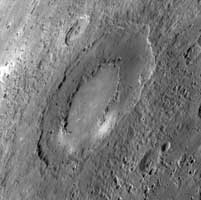|
COMETS EARTH JUPITER KUIPER BELT MARS MERCURY METEORITES NEPTUNE OORT CLOUD PLUTO SATURN SOLAR SYSTEM SPACE SUN URANUS VENUS ORDER PRINTS
PHOTO CATEGORIES SCIENCEVIEWS AMERICAN INDIAN AMPHIBIANS BIRDS BUGS FINE ART FOSSILS THE ISLANDS HISTORICAL PHOTOS MAMMALS OTHER PARKS PLANTS RELIGIOUS REPTILES SCIENCEVIEWS PRINTS
|
Related Documents
Download Options
Date Acquired: September 29, 2009 This unnamed impact basin was seen for the first time yesterday during MESSENGERís third flyby of Mercury. The outer diameter of the basin is approximately 260 kilometers (160 miles). This basin has a double-ring structure common to basins with diameters larger than 200 kilometers (about 125 miles). The floor of the basin consists of smooth plains material. Concentric troughs, formed by surface extension, are visible on the basin floor, similar to those seen in Raditladi basin. Such troughs are rare on Mercury, and the discovery of such features in this newly imaged basin is of great interest to members of the MESSENGER Science Team. Crater chains produced during ejecta emplacement also can be seen emanating from the basin. Credit: NASA/Johns Hopkins University Applied Physics Laboratory/Carnegie Institution of Washington |
